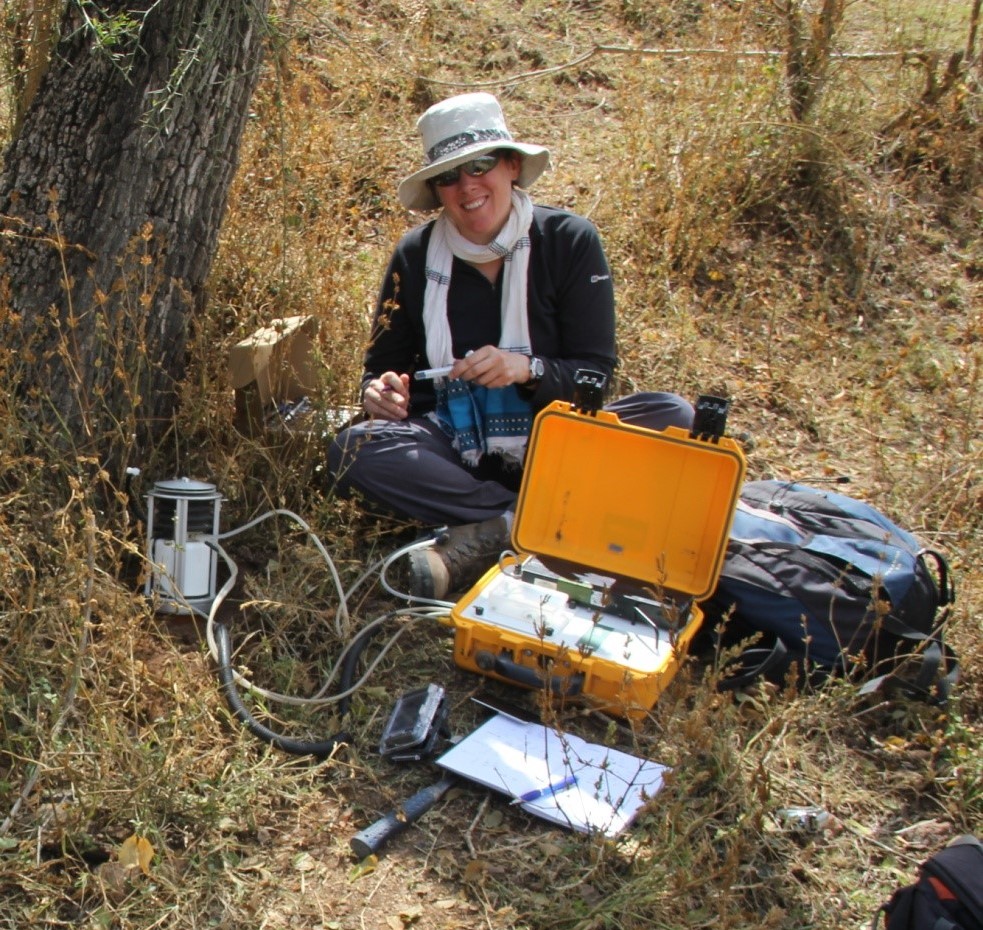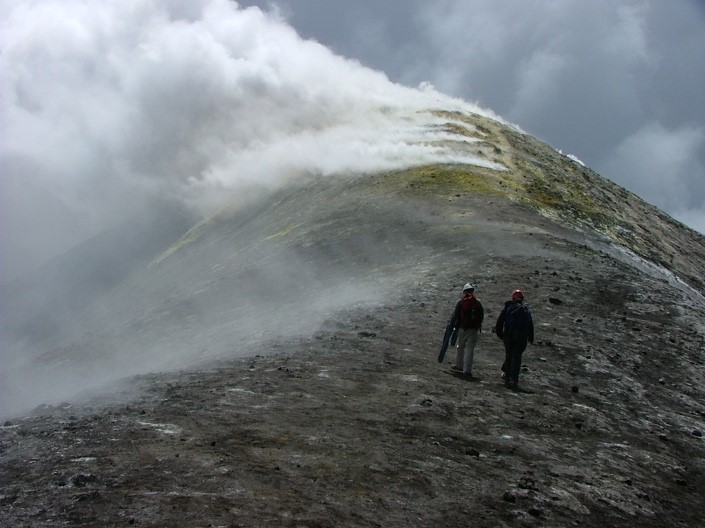Professor Tamsin Mather (1995) studied Natural Sciences at St John’s specialising in Chemistry and then returned in 2001 to do a PhD in Earth Sciences. She is now a Professor of Volcanology at the University of Oxford. Her work has taken her all over the globe in a quest to understand more about the world’s volcanoes.

Unlike some of my colleagues, for whom volcanoes were their childhood passion, I never set out to be a volcanologist. With the wisdom of hindsight, my eventual career path makes some sort of sense and I can see that some seeds were sown during my undergraduate days. Visiting one of my friends from St John’s in the Easter vacation of 1998, during their Modern Languages year abroad on Réunion Island in the Indian Ocean, brought me face to face with my first erupting volcano (I still have the fading photos from that trip on my office wall in Oxford). The generosity of the College travel grants scheme allowed me to feed my passion for adventure by participating in the Tall Ships Race that same summer. My love of the sea and sailing almost led me to do a PhD in ocean chemistry but we were required to put a second-choice project down and I spotted one on the atmospheric chemistry of volcanic plumes. Reading more, I was hooked.
Volcanoes can be both inspiring and terrifying. I have just returned from a long-delayed trip to the Bay of Naples, including a visit to the archaeological remains of Herculaneum. The skeletons there of more than 100 people who were trapped in the seaside chambers and killed in the AD79 eruption of Vesuvius are a grim reminder of what volcanoes can do. It is estimated that this ancient eruption killed over 13 thousand people, but far greater volcanic tragedies have happened more recently. For example, the 1985 eruption of Nevado del Ruiz in Colombia triggered volcanic mudslides that killed more than 23 thousand people. We still have much to learn about how to save lives and livelihoods from such destruction.
In the small settlement of El Panama, just three kilometres from the volcano, people cannot use nails to fix the roofs of their houses, as they rust too quickly in the volcanic gases.
Some of my work seeks to better understand the hazards that volcanoes present, and ultimately arm those in charge of monitoring and advising local populations with better information. Satellite technology has given us new insights into volcanic behaviour and these days we are able to look for changes in a volcano’s shape (whether swelling or subsiding), heat and gas emissions on a global scale from space. This means that we are no longer limited to gathering data on those volcanoes that are well instrumented, but can gather and share information globally with observatories and hazard managers. We can also now look for wider-scale patterns in the behaviour of Earth’s volcanoes over time, in a similar way to how medics can study population health to look for trends with different risk factors.
A more traditional approach to understanding future hazards at a specific volcano is by piecing together its past activity via study of the rocky deposits that built its structure and the layers of ash that its explosions have left buried in the surrounding landscape. A few years back we surveyed a section of the East African Rift in Ethiopia with local colleagues and found that several volcanoes had been much more active in their recent past than others. This allowed us to make predictions about what to look out for next in terms of volcanism in this region.

Our work in Ethiopia illustrates another important motive for understanding volcanism. Volcanoes are not only hazards, they are also resources. Magmas play a key role in the formation of some of the metal-rich ore deposits that so much of today’s technology relies on. The fluids that flow through active volcanoes are rich in critical metals, and are a source of green power when harnessed effectively. Ethiopia is estimated to have over 10,000 MW of geothermal energy potential, more than double its current power generating capacity. At the moment Aluto, one of the volcanoes that we targeted for study, hosts the country’s only operational geothermal project; and our work on its past volcanic behaviour and the patterns of gas seeping from its edifice provides useful information for those seeking to harness its power further.
One of the things that fascinates me most about volcanoes is the impact that they have on our planet’s environment. My first field trip for my PhD was to Masaya volcano in Nicaragua and I have been back many times since. Although it has not had a significant eruption recently, Masaya is a chronic and persistent source of noxious volcanic gases, including sulphur dioxide and hydrochloric acid. The low-altitude volcano fumigates the local environment, with its fumes hugging the ridged terrain downwind. In the small settlement of El Panama, just three kilometres from the volcano, people cannot use nails to fix the roofs of their houses, as they rust too quickly in the volcanic gases. Local farmers there have switched from growing the usual cash crop of coffee to pineapples and dragon fruit, which are more resistant to the volcano’s acidic cocktail. Over the years I have worked with teams in Nicaragua, Iceland and Hawai‘i to understand better the impacts of this volcanic fumigation on air quality and livelihoods.
Perhaps surprisingly it also turns out that some of the lessons learnt while sitting in the noxious fumes at Masaya and other volcanoes have a deeper relevance to life and evolution. Over the millions of years of the geological record, Earth’s history has been punctuated by great outpourings of lava. These events known as ‘large igneous provinces’ last about a million years, put out about a million cubic kilometres of rocks onto the planet’s surface and pump out vast quantities of carbon dioxide, sulphurous and acidic gases. Each of the Earth’s continents contains at least some evidence of this mighty mode of volcanism, and their remnants lurk beneath the ocean’s waves in places too. Although other triggers (like the famous asteroid impact coinciding with the demise of the dinosaurs) are also in play, the ages of the rocks from these vast provinces often match up in the geological record with periods of planetary-scale environmental change, including many of the most dramatic mass-extinction events encoded in the fossil record. Work understanding the atmospheric chemistry of volcanic plumes today helps us to better understand how these ecological disasters might have played out tens to hundreds of millions of years ago. While their potential part in triggering mass extinctions might seem like further evidence of volcanoes as agents of mass destruction, it is worth reflecting that without these periods of large-scale biological reorganisation mammals and ultimately humans may not have found their ecological niche.

Volcanoes shape human lives in many different ways today, and have been fundamental to the evolution of our world. They have been significant agents in carving out our place on the planet and for me they are a source of endless fascination.
You can find out more about Tamsin and her work on her webpage: https://www.earth.ox.ac.uk/people/mather/




